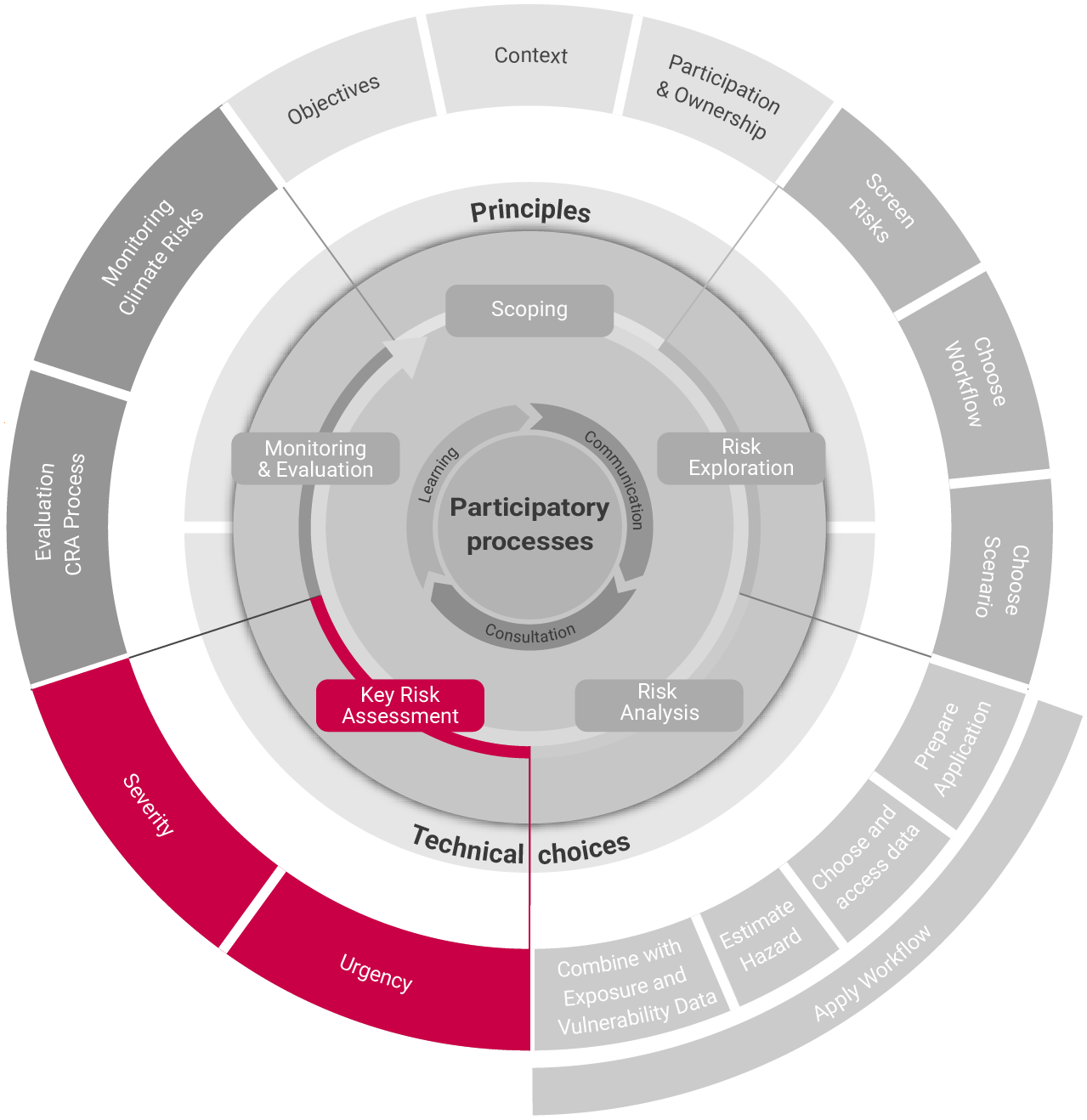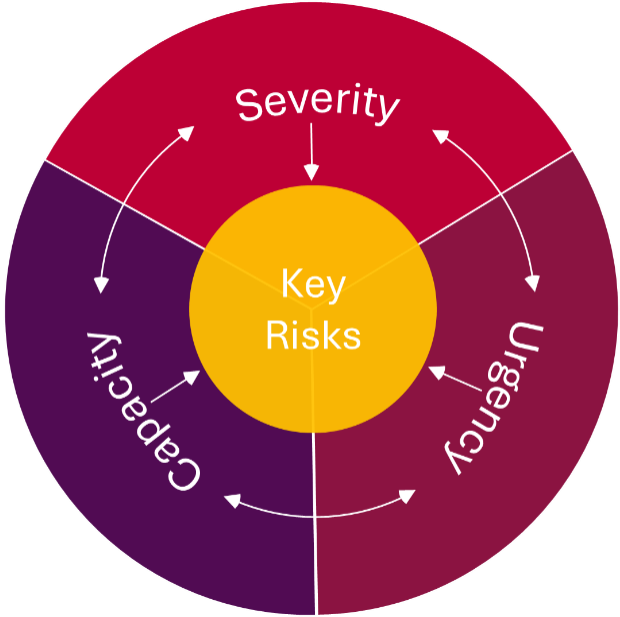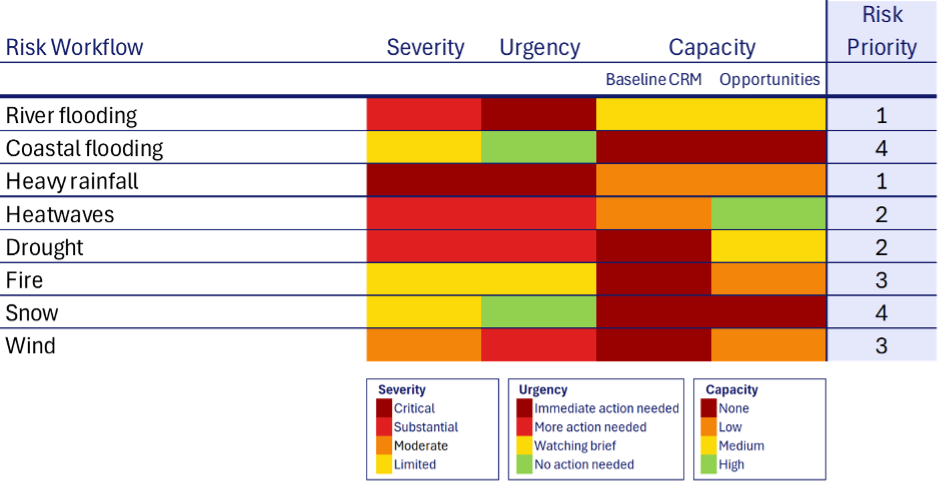Key Risk Assessment#

The outputs of the climate risk analysis generate quantitative information on climate risks and their impacts. These results remain to be interpreted within a regional/local context to support prioritization of risks. Therefore, as a further analytical step, risk needs to be evaluated to identify key risks in terms of severity and urgency as well as regarding a region’s/community’s resilience capacity to cope with and adapt to a specific risk. This step allows for the integration of responses to risk – the fourth driver of risk according to the IPCC Risk Propeller, therefore connecting the individual risk context of a region/community and its resilience capacity with future directions for CRM. For this, consultation and involvement of selected stakeholders, experts and priority groups is essential to collect information on the perception of risks. These may be harnessed e.g., via stakeholder workshops or focus group discussions.
Tip
The Key Risk Assessment step is a crucial point for reflecting on principles from the conceptual background (especially social justice/just resilience and the precautionary approach) as well as context, objectives and risk ownership that were set during the Scoping step.
Assessing severity and urgency supports the understanding of risk outcomes by interpreting the output metrics in each regional/local context. Further, reviewing the resilience capacity of a region to deal with the risk may pinpoint strengths and weaknesses respectively to the relative risk (Table 8). Applying this social risk evaluation process to several climate risks allows for priority risk ranking, thus informing future CRM needs. Severity, urgency, and resilience capacity are interdependent and may influence one another, potentially requiring a dynamic evaluation process that moves back and forth between these three elements (Fig. 25).
Severity emerges from the previous risk estimation step (risk analysis outcome), providing information on magnitude of risk or changes in frequency. A sensemaking process of the risk outcomes in terms of potential physical, social, ecological and financial impact and damage supports its contextualization within the individual region/community situation. Additionally, irreversibility or cascading effects may be considered, where information is available. For example, a flood event in a certain area may destroy housing, recreational areas or important businesses, which consequently can trigger long-term economic damage or even social unrest.
Urgency refers to the temporal dimension of hazard. It depends on the rate of change (current and future severity; indicated above) as well as timing of occurrence, persistence, or hazard acceleration trends (slow-onset vs. sudden-onset). For instance, hazards that appear to be changing quickly or sooner than expected, increase urgency.
Resilience capacity corresponds to the ability to cope, adapt and transform to actual and potential harm triggered by climate change. Considering physical, social, financial, human, or natural resilience capacities supports a broad assessment of the status quo and additionally enables an exploration of adaptation gaps, which is relevant for informing future CRM options. For example, a region may have limited financial resources but may yet benefit from favorable policy conditions and a healthy surrounding ecosystem, both of which can significantly enhance flood risk reduction efforts.

Fig. 25 Key Risk Assessment conceptualisation
considering severity, urgency and capacity.
Credit: CLIMAAX consortium.#
Severity |
Urgency |
Resilience Capacity |
|---|---|---|
Risks are considered severe if potential impacts
|
Urgency is related to the time components of hazard and depends on
|
Capacity considers any ability to absorb, adapt to and transform respective risk, originating
|
Tip
To prioritize quantified climate risk within the CLIMAAX toolbox, it is recommended to self-assess severity, urgency and resilience capacity within your regional/communal context. You can access a protocol that guides you through the process together with a dashboard template to support you in your individual evaluation process.
Self-assessment and evaluation of the mentioned elements within the Key Risk Assessment step integrate into a risk dashboard for risk prioritization (Fig. 26). The assessment should draw on participatory processes to include bottom-up perspectives and may thus involve stakeholders, experts from various fields and representatives of priority groups. The outcome of evaluating selected risks results in risk prioritization, thus identifying “key” risks. These priorities may then be directly translated to CRM strategies and plans, while other risks would be further monitored.

Fig. 26 Example of Key Risk Assessment through risk ranking, considering severity (of current – C and future – F risk), urgency and resilience capacity. The overall outcome suggests risk prioritization indicating key and less urgent risks. Source: Adapted from European Climate Risk Assessment (EEA 2024).#
Tip
Even if only one risk workflow has been chosen, regions can still profit by adding more detail to the climate risk analyzed by assessing e.g., expected impacts, time components, or CRM measures that are already in place to tackle the respective risk.
